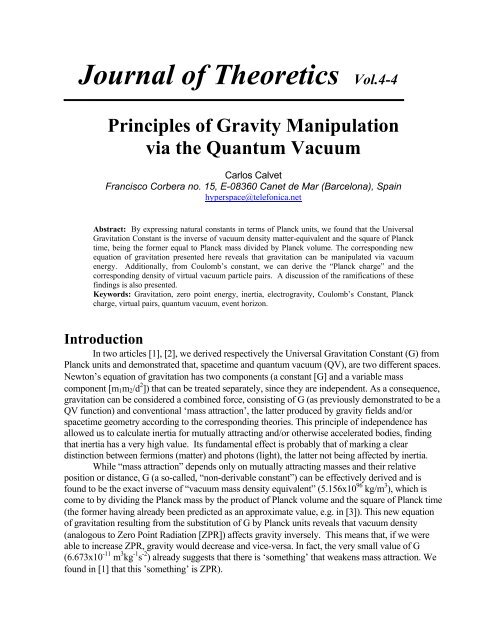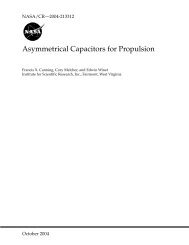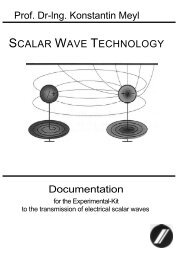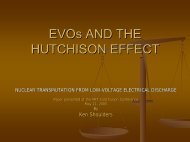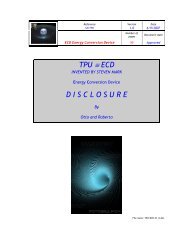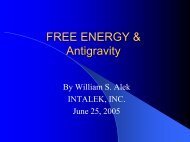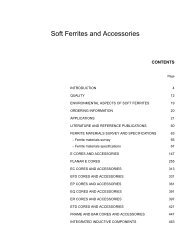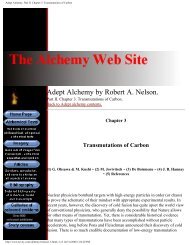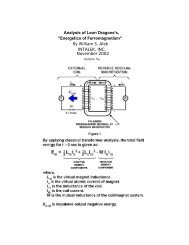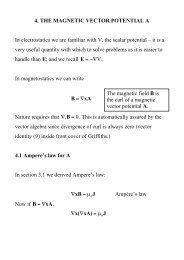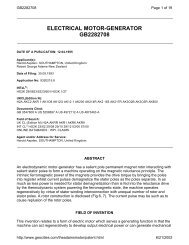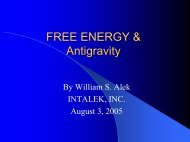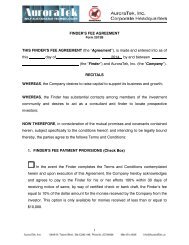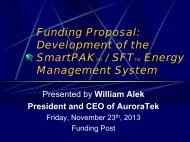Principles of gravity manipulation and - Journal of Theoretics
Principles of gravity manipulation and - Journal of Theoretics
Principles of gravity manipulation and - Journal of Theoretics
You also want an ePaper? Increase the reach of your titles
YUMPU automatically turns print PDFs into web optimized ePapers that Google loves.
<strong>Journal</strong> <strong>of</strong> <strong>Theoretics</strong> Vol.4-4<strong>Principles</strong> <strong>of</strong> Gravity Manipulationvia the Quantum VacuumCarlos CalvetFrancisco Corbera no. 15, E-08360 Canet de Mar (Barcelona), Spainhyperspace@telefonica.netAbstract: By expressing natural constants in terms <strong>of</strong> Planck units, we found that the UniversalGravitation Constant is the inverse <strong>of</strong> vacuum density matter-equivalent <strong>and</strong> the square <strong>of</strong> Plancktime, being the former equal to Planck mass divided by Planck volume. The corresponding newequation <strong>of</strong> gravitation presented here reveals that gravitation can be manipulated via vacuumenergy. Additionally, from Coulomb’s constant, we can derive the “Planck charge” <strong>and</strong> thecorresponding density <strong>of</strong> virtual vacuum particle pairs. A discussion <strong>of</strong> the ramifications <strong>of</strong> thesefindings is also presented.Keywords: Gravitation, zero point energy, inertia, electro<strong>gravity</strong>, Coulomb’s Constant, Planckcharge, virtual pairs, quantum vacuum, event horizon.IntroductionIn two articles [1], [2], we derived respectively the Universal Gravitation Constant (G) fromPlanck units <strong>and</strong> demonstrated that, spacetime <strong>and</strong> quantum vacuum (QV), are two different spaces.Newton’s equation <strong>of</strong> gravitation has two components (a constant [G] <strong>and</strong> a variable masscomponent [m 1 m 2 /d 2 ]) that can be treated separately, since they are independent. As a consequence,gravitation can be considered a combined force, consisting <strong>of</strong> G (as previously demonstrated to be aQV function) <strong>and</strong> conventional ‘mass attraction’, the latter produced by <strong>gravity</strong> fields <strong>and</strong>/orspacetime geometry according to the corresponding theories. This principle <strong>of</strong> independence hasallowed us to calculate inertia for mutually attracting <strong>and</strong>/or otherwise accelerated bodies, findingthat inertia has a very high value. Its fundamental effect is probably that <strong>of</strong> marking a cleardistinction between fermions (matter) <strong>and</strong> photons (light), the latter not being affected by inertia.While “mass attraction” depends only on mutually attracting masses <strong>and</strong> their relativeposition or distance, G (a so-called, “non-derivable constant”) can be effectively derived <strong>and</strong> isfound to be the exact inverse <strong>of</strong> “vacuum mass density equivalent” (5.156x10 96 kg/m 3 ), which iscome to by dividing the Planck mass by the product <strong>of</strong> Planck volume <strong>and</strong> the square <strong>of</strong> Planck time(the former having already been predicted as an approximate value, e.g. in [3]). This new equation<strong>of</strong> gravitation resulting from the substitution <strong>of</strong> G by Planck units reveals that vacuum density(analogous to Zero Point Radiation [ZPR]) affects <strong>gravity</strong> inversely. This means that, if we wereable to increase ZPR, <strong>gravity</strong> would decrease <strong>and</strong> vice-versa. In fact, the very small value <strong>of</strong> G(6.673x10 -11 m 3 kg -1 s -2 ) already suggests that there is ‘something’ that weakens mass attraction. Wefound in [1] that this ’something’ is ZPR).
The above findings, in combination with so-called "weak gravitation shielding experiments”([4], [5]), reveal that <strong>gravity</strong> can be effectively manipulated via QV by using superconductorarrangements.In our second article [2], we derived the ‘Planck charge’ (generally unknown or as the‘electron charge’ misunderstood with a value <strong>of</strong> 1.876x10 -18 C) from Coulomb’s Constant (C),corresponding to the charge existing in a QV-Planck volume. By comparing the corresponding QVlepton/photon ratio with the almost equivalent baryon/photon ratio predicted for spacetime by theSt<strong>and</strong>ard Model, we found that the former is about 12 orders <strong>of</strong> magnitude lower, allowing it to besaid that under any circumstance, spacetime <strong>and</strong> QV are two different spaces (even if we correctedsomehow for the corresponding ratios, the difference would be still too large to be merelyinsignificant).These findings allow us to determine that spacetime is mainly a space full <strong>of</strong> neutral matter<strong>and</strong> much light, while the QV is mainly a space full <strong>of</strong> strong radiation <strong>and</strong> some charges (virtualpairs), such that both universes are effectively incompatible <strong>and</strong> ought to exist therefore - even froma theoretical point <strong>of</strong> view - as separated spaces in the universe.By dividing the Planck charge by the charge <strong>of</strong> the electron (1.6022x10 -19 C), we obtain anaverage density <strong>of</strong> 11.71 leptons per Planck volume, which per definition corresponds to the wellknownvirtual electron-positron pairs that create <strong>and</strong> mutually annihilate each other in vacuum. Atthe very moment <strong>of</strong> their mutual interaction, approximately 12 entire leptons correspond to 6particles or strings, what is coincident with the 6 Kaluza-Klein dimensions, attributed to strings.This coincidence allows the establishment <strong>of</strong> a direct link between strings <strong>and</strong> the QV asalready suggested by The California Institute for Physics <strong>and</strong> Astrophysics in its homepage (“It nowappears that quantum field theory may be the low energy limit <strong>of</strong> superstring theory”) <strong>and</strong> suggeststhat the QV is the space where strings are physically located. This model would explain the effectknown as ‘quantum non-locality’, since strings (in so-called ‘entangled particles’) would interactinstantly via the QV in a time that is zero for spacetime observers, since the QV disposes <strong>of</strong> adifferent time frame than spacetime because <strong>of</strong> its different number <strong>of</strong> dimensions, <strong>and</strong> thereforeQV-time has no meaning to us.Gravity ManipulationAs already shown in [1], vacuum mass-density equivalent can be understood, per definition,as a Planck mass existing in a Planck volume:δZP=mlP3P−8−82.177x10kg 2.177x10kg96 −3== 5.159x10kg3−1053= m4.220x10m−35( 1.616x10m), (1)where: δ ZP = vacuum mass-density equivalent, m P = Planck mass, <strong>and</strong> l 3 P = V P (Planck volume).Also see [3] for a parallel derivation.By substituting G with the corresponding Planck units, we get:1G = , (2)δ2ZPt P
<strong>and</strong> substituting:1 −113 −1−2= 6.670 x10m kg96 − 3−442G = 5.159 x10kg m (5.391x10s)s , (3)which is equal (to the rounded decimals) to the normal value <strong>of</strong> G (6.673x10 -11 m 3 kg -1 s -2 ) <strong>and</strong>demonstrates that G corresponds effectively to function (2), i.e., that G is a quantum-function.In consequence, Newton’s equation <strong>of</strong> gravitation adopts the following form by substitutingG by eq. (2):1 m1m2F = . (4)2 2t dδ ZPPIn this equation, we call the above-mentioned independent right component “massattraction” because it depends only on masses <strong>and</strong> their relative position. According to the “causeeffectprinciple”, the left component (G) can be considered a “vacuum reaction” to gravitation, sincematter is obviously the origin <strong>of</strong> any gravitation. (A similar vacuum reaction to accelerated matter isknown as Davies-Unruh effect [9], [10] <strong>and</strong> demonstrates that the vacuum effectively reacts to thepresence <strong>of</strong> matter. In addition, since in eq. (4), δ ZP represents a vacuum mass-density equivalent,any reaction to gravitation represents a vacuum effect).The first we observe in eq. (4) is that <strong>gravity</strong> is inversely proportional to vacuum energy(δ ZP ). In consequence, if we manipulated vacuum energy, we would in parallel be manipulating<strong>gravity</strong>. Further, if the QV did not exist, ZPR would be zero <strong>and</strong> according to (4), the gravitationalforce would be infinite while the opposite would occur if ZPR was infinite (<strong>gravity</strong> would be zero).In [11], we already mentioned a herewith-related case with regard to the extreme high temperature<strong>of</strong> the solar corona (up to 2x10 6 °C) with respect to the photosphere or surface <strong>of</strong> the sun (only5,500°C). Probably, the very dense solar photon stream produces “holes” in the fabric <strong>of</strong> spacetime,so that the ZPR emerges from QV <strong>and</strong> heats up the solar corona. In consequence, we predict that inthe solar corona, <strong>gravity</strong> could be weaker than normal.To underst<strong>and</strong> the nature <strong>of</strong> the QV <strong>and</strong> why ZPR is able to reduce <strong>gravity</strong>, we make thefollowing experiment <strong>of</strong> thought:Imagine a flat universe (sheet) located in spacetime (our frame). Any spacetime radiationthat crosses the sheet, will produce effects in the sheet, but will not remain there. Eventually theinhabitants <strong>of</strong> the sheet (flatl<strong>and</strong>ers) will notice radiation effects, but will see no radiation.Analogous happens in our universe: vacuum radiation that crosses spacetime, produces Casimir-likeeffects, but cannot be seen nor detected because <strong>of</strong> its alien location.Since the QV is a 6-D space [2] that surrounds 4-D spacetime completely due to its naturalsuperior extension, spacetime matter is completely surrounded by ZPR. If an object is movinguniformly or at rest, ZPR will be the same on any surface. But as soon as the object accelerates, aDoppler-effect takes place (see also [3] for analogous explanation), so that ZPR becomes moredense in the direction <strong>of</strong> movement <strong>and</strong> less dense behind the object. This produces a higher ZPRpressure in the opposite direction <strong>of</strong> the movement, so that an effective “vacuum reaction” takesplace, with the consequence that the initial acceleration is reduced. This effect is commonly knownas ‘inertia’ <strong>and</strong> per definition also somehow related to the much weaker Davies-Unruh effect. Thismeans that the vacuum reacts to acceleration by opposing ZPR-borne inertia.
In the case <strong>of</strong> static bodies, ZPR produces a homogenous radiation pressure, so that no neatvacuum reaction nor inertia takes place. But if we managed to increase ZPR, according to (4), wewould induce a vacuum reaction artificially <strong>and</strong> gravitation would therefore weaken in a parallelextent. In consequence, not only the acceleration is able to produce vacuum reaction (Davies-Unruh,inertia), but also any phenomenon that affects vacuum density.This can be understood as a vacuum reaction opposite to the existing gravitational fields.Through Newton’s equation <strong>of</strong> motion, F=m·a, any body subjected to a field <strong>of</strong> force (in this case,gravitation), is also subjected to a potential acceleration toward attracting bodies. In consequence,the vacuum reaction will produce a reaction force via ZPR pressure that is opposed to the maindirection <strong>of</strong> the corresponding gravitational fields, with the final result that, even bodies in a stiffgravitational system are subjected to a neat ZPR reaction force opposite to the direction <strong>of</strong> the field(although not to inertia, since they are not accelerated. In consequence, inertia <strong>and</strong> vacuum reactionto forces differ in stiff systems <strong>and</strong> are not exactly the same).With the above model in mind, we interpret Podkletnov’s famous "weak gravitationshielding experiment” as the obvious result <strong>of</strong> QV <strong>manipulation</strong> with the aid <strong>of</strong> electromagnetic(EM) fields, produced by a spinning superconductor. In effect, it seems that the fields induced bythe superconductor <strong>and</strong>/or the coils used for levitation, did increase local ZPR, probably byuploading photons from EM fields to the QV. At that point, according to eq. (4), the higher ZPRshould have reduced <strong>gravity</strong>, which was effectively observed by Podkletnov [4] <strong>and</strong> later also by Li[5] <strong>and</strong> several others.This means that, it was not the superconductor itself that affected <strong>gravity</strong>, but the resultingEM fields. Probably, a flow <strong>of</strong> photons from spacetime to the QV takes place if strong EM fieldsinteract mutually, e.g. by making one field rotate inside another as in [4]. The resulting ‘friction’between both fields could provide the necessary energy to upload photons from spacetime fields tothe QV, thus increasing local ZPR <strong>and</strong> reducing <strong>gravity</strong> according to eq. (4).This principle suggests further that ZPR is not uniform in the universe, but that there couldbe many local phenomena that increase or decrease vacuum energy, making therefore respectivelydecrease or increase the local <strong>gravity</strong>. The universe can be in this sense understood at least as a giant<strong>gravity</strong> device via the QV. The expansion <strong>of</strong> the universe could be so, at least in part, interpreted asthe result <strong>of</strong> ZPR repulsion on matter. Emerging ZPR in intergalactic space could explainintergalactic voids as well as the global dispersion <strong>of</strong> the universe.To alter ZPR, we could use any kind <strong>of</strong> device or system, able to create a photon flow froma QV to spacetime <strong>and</strong>/or vice-versa. It seems at this stage easier to weaken <strong>gravity</strong> by mutuallyinterfering, intense spinning EM fields, or by flooding tiny spaces with large amounts <strong>of</strong> photons[11], than to increase <strong>gravity</strong> by contrary means.Anyhow, to increase <strong>gravity</strong>, it would be necessary to extract photons from QV. This maybe the way that black holes, neutron stars <strong>and</strong> other dense objects do produce or absorb someradiation <strong>of</strong> this kind. By compressing supercold matter (Bose-Einstein condensate), instead <strong>of</strong>obtaining a fusion as in a conventional hydrogen bomb, as we have already suggested in [12], itshould be able to create superdense matter. Arranging this matter in devices, it should be able todownload photons from the QV in order to increase local <strong>gravity</strong>. A spacecraft equipped with acombination <strong>of</strong> several <strong>of</strong> the above-mentioned technologies, should be able to navigate without theneed <strong>of</strong> any propulsion, at least in the proximities <strong>of</strong> celestial objects.All the above-mentioned are methods dedicated to alter locally Gravitational Constant, ‘G’.But the right component <strong>of</strong> eq. (4), which consists <strong>of</strong> “mass attraction”, is the phenomenon that, inprinciple, induces a vacuum reaction (left component). This means that, apart from the vacuum
eaction, masses attract mutually by some sort <strong>of</strong> a ‘gravitational field’ or ‘spacetime geometry’ aspredicted by quantum field theories <strong>and</strong> general relativity, respectively. Therefore, another way toalter <strong>gravity</strong> would be by manipulating such fields or geometries - a theme that is out <strong>of</strong> the scope <strong>of</strong>this paper.The novelty <strong>of</strong> eq. (4) is that it demonstrates that quantum <strong>gravity</strong> is not really subjected toany kind <strong>of</strong> constant, but that it is the result <strong>of</strong> the balance between gravitational attraction <strong>and</strong>vacuum repulsion on spacetime objects subjected to ZPR. Nature has probably provided thisapparently complex system to allow a more stable universe that is not subject to unbiased <strong>and</strong>/orinfinite field intensities <strong>and</strong>/or accelerations [1]. A universe without a QV component wouldprobably be a very chaotic place if it had ever existed at all.Following an analogous method as once Max Planck did when he derived Planck units fromnatural constants, <strong>and</strong> expressing Coulomb’s Constant (C = 8.988x10 9 Nm 2 /C 2 ) in term <strong>of</strong> Planckunits, in [2] we found the charge contained in a Planck volume (Planck charge):qP128 −1( 2.998x10ms )2−82−35⎛ m c l ⎞ ⎛P P2.177x10kg1.616x10m ⎞−18= ⎜⎟⎜= 1.876x10C9 2 −2C⎟ =. (5)⎝ ⎠⎜8.988x10Nm C⎟⎝⎠12This charge, divided by the charge <strong>of</strong> the electron (1.6022x10 -19 C), renders the amount <strong>of</strong> 11.71leptons per Planck volume, corresponding to well-known virtual electron-positron pairs.Since Coulomb’s Constant is a function <strong>of</strong> vacuum permittivity (ε 0 ) <strong>and</strong>/or permeability(µ 0 ), Planck charge can be interpreted as the charge <strong>of</strong> virtual pairs existing in vacuum. Inconsequence, any vacuum Planck volume contains 11.71 virtual leptons. Because 11.71 is amean value, there can be 10, 11, 12, 13 etc. leptons at any time in a Planck volume, with 12being the closest integer value.These 12 leptons would correspond to 6 virtual pairs. It is known that any pair mutuallyannihilates <strong>and</strong> produces a gamma particle pair, which again mutually annihilate <strong>and</strong> renders anelectron-positron pair in an almost immediate <strong>and</strong> endless sequence inside a confined space. Atthe very moment <strong>of</strong> their mutual interaction, 12 leptons/gamma particles fuse <strong>and</strong> represent thevolume <strong>of</strong> 6 particles/strings. Since any string is considered to be one-dimensional <strong>and</strong> <strong>of</strong> thePlanck length, 6 strings would fill up the space corresponding to a 6 dimensional Planck volume.Since the above-mentioned 6 virtual pairs are contained in a Planck volume thataccording to Coulomb’s Constant is a vacuum, it results that quantum vacuum is a 6-dimensional space. (In fact, 6 one-dimensional strings concentrated in one spot have, perdefinition, the extension <strong>of</strong> a 6-dimensional Planck volume).In [2], we also showed that, by comparing the fermion/photon ratio <strong>of</strong> spacetime <strong>and</strong> QV,it results that the QV contains 12 orders <strong>of</strong> magnitude more photons than spacetime. Thisenormous difference between these principally infinite macroscopic spaces, together with theabove 6 dimensions that are found to exist in a QV, demonstrate that the QV <strong>and</strong> spacetime aredifferent spaces, i.e. that they are not the same space.Further, it is generally known from string theory that particles consist <strong>of</strong> 10-dimensionalstrings. These 10 dimensions correspond to 4 outside spacetime dimensions (the outer shell <strong>of</strong>the corresponding particle) <strong>and</strong> 6 curled dimensions inside string environment that are supposedto be a relic <strong>of</strong> the Big Bang, so that the original 10 dimensional particle that exploded at thebeginning <strong>of</strong> the universe rendered a large amount <strong>of</strong> smaller particles that carry inside curled 6-dimensional (Kaluza-Klein) universes, each about the Planck size.
The 6 dimensions attributed to string environment coincide exactly with the number <strong>of</strong> 6dimensions we found to exist in the QV. In consequence, the QV can be considered the mediumin which strings are located, such that any Kaluza-Klein universe that surrounds a particularstring would be connected to the QV through a path to the ‘other side’ that is not directlyaccessible through spacetime under normal conditions.On the other h<strong>and</strong>, it is generally known that entangled particles do display a so-called‘non-locality’. That is the ability <strong>of</strong> particles like bosons to get synchronized at very largedistances <strong>and</strong> is interpreted as the immediate interchange <strong>of</strong> information in a time that is zero forspacetime observers (see [13] for additional explanation).With our model <strong>of</strong> strings that are surrounded by a 6-dimensional QV, particle nonlocalitycan be easily understood as the ability <strong>of</strong> elementary particles to interact through the QV.As previously mentioned, each particle can be understood as consisting <strong>of</strong> an outer 4-dimensional shell (spacetime side) <strong>and</strong> an inner 6-dimensional string (QV side). While the outershell would be responsible, e.g. for conventional photon interchange via spacetime, the innershell would be responsible for mutual ‘communication’ that is known to exist in entangledparticles. Since communication in 6-dimensional QV happens in a time frame beyond 4-dimensional spacetime, any QV interaction happens in a time that has no meaning for spacetimeobservers (i.e., the time needed by two entangled particles to interact results to be zero for us <strong>and</strong>for all <strong>of</strong> our spacetime devices).As a result, our universe can be understood as consisting <strong>of</strong> two different spaces(spacetime <strong>and</strong> QV) linked together by elementary particles, such that the outer shell <strong>of</strong> anyparticle corresponds to the well known 4-dimensional particle, while the inner side is built up bya string surrounded by a local portion <strong>of</strong> the 6-dimensional QV. Generally speaking, any particlecan be considered as being a small window to the QV.DiscussionIn the past, there has been no possibility to fuse these tiny windows in order to create awindow that is large enough to be used, e.g. as a path to the ‘other side’, but the recentdiscovering <strong>of</strong> so-called “Bose-Einstein condensation” (BEC) makes it now possible. In fact, at atemperature <strong>of</strong> only one-billionth degree Kelvin, atoms turn into matter waves <strong>and</strong> acquirequantum properties. This means that BEC atoms behave like bosons <strong>and</strong> that they are able tooverlap <strong>and</strong> to produce a single wave made out <strong>of</strong> all the small waves that constitute thecorresponding atoms.By fusing supercold atoms into a matter wave, what we would really be doing iseliminating the outer 4-dimensional shell <strong>of</strong> elementary particles, thus allowing the 6-dimensional QV to emerge <strong>and</strong> provide quantum properties to the wave, which are per definitionusually confined inside the QV. By fusing a large amount <strong>of</strong> particles into one single wave, allKaluza-Klein universes <strong>of</strong> the corresponding strings would also fuse, building a path to the QV,which could theoretically be enlarged with awesome potential. One possible use would betransportation through the great expanses <strong>of</strong> space.A matter wave can be further understood as the “event horizon” <strong>of</strong> the border betweenspacetime <strong>and</strong> QV, resembling the event horizon <strong>of</strong> a black hole to some degree. In this sense, amatter wave (in opposition to a light wave) acts as a large window or path between spacetime<strong>and</strong> the QV. (Light can be understood as consisting <strong>of</strong> strings that are not connected to the QV<strong>and</strong> just simply “ride” upon spacetime fabrics. This ‘simple’ difference would mark thefundamental difference between matter <strong>and</strong> energy).
Theoretically, in order for a large BEC window to be used as a path for devices or probesto explore the other side, we ought to be able to create a BEC that is large enough for thispurpose. Currently the BEC is very fragile <strong>and</strong> consists only <strong>of</strong> a diluted cloud <strong>of</strong> dispersedatoms. A technically useful BEC-window should consist <strong>of</strong> a large dense mass <strong>of</strong> BEC that iscondensed solid matter, large enough, to provide sufficient space <strong>and</strong> dynamism fortransportation through it. To achieve such a goal, we must improve the current techniques thatallow creation <strong>of</strong> BEC (i.e., magnetic traps, laser light spotting, etc.) <strong>and</strong> use more powerfulones, such as matter blocks submerged in a circuit filled with a superfluid (e.g., He-4). Even ifsuperfluids are not perfect BECs, a counter-flow <strong>of</strong> such fluids will produce a constant energyloss in matter blocks submerged in that flow, eventually until the BEC-temperature. Inconsequence, even with relatively simple technologies, it might be possible to produce largeblocks <strong>of</strong> BEC, by just using the right technique.Despite any difficulty that could exist in producing the above-mentioned technology, we areconfident that they are in reach within the following 25 years or even earlier if these ideas areexplored expeditiously.ConclusionSuch ideas have been criticized about not using relativistic approaches to the correspondingequations presented. But this criticism is senseless because at the Planck level, there is no relativity.Max Planck derived his fundamental units directly from natural constants without using anyrelativistic approaches. Natural constants also provide information about the QV directly. In thissense, the speed <strong>of</strong> light is the exact value <strong>of</strong> Planck length divided by Planck time <strong>and</strong> vacuumenergy corresponds exactly to Planck mass divided by Planck volume. Relativity probably takesplace somewhere between the Planck world <strong>and</strong> normal level. But neither the Planck level nor thecosmological level seem to be subjected to any sort <strong>of</strong> relativity – they are fundamental <strong>and</strong> so aresuch concepts.References[1] Carlos Calvet, “Gravitation <strong>and</strong> inertia as a consequence <strong>of</strong> Quantum Vacuum Energy”,<strong>Journal</strong> <strong>of</strong> <strong>Theoretics</strong>, Vol. 4, No. 2, April 2002 (preprint).[2] Carlos Calvet, “About the quantum vacuum lepton/photon ratio”, <strong>Journal</strong> <strong>of</strong> <strong>Theoretics</strong>,Vol. 4, No. 2, April 2002 (preprint).[3] H.E. Puth<strong>of</strong>f, “The Energetic Vacuum: Implications For Energy Research, Speculationsin Science <strong>and</strong> Technology”, Vol. 13, No. 4, pp. 247-257 (1990).[4] E.E. Podkletnov (Moscow Chem. Scientific. Ctr.), "Weak Gravitation ShieldingProperties <strong>of</strong> Composite Bulk YBa2Cu3O7-x Superconductor Below 70°K under E.M. Field,"Univ. Cincinnati Engineering, report # MSU-chem 95, abstract cond-mat/9701074, 19 pp.(1997).[5] N. Li, D. Noever, T. Robertson, R. Koczor <strong>and</strong> W. Brantley, “Static Test for A GravitationalForce Coupled to Type II YBCO Superconductors”, Physica C, Vol. 281, pp. 260-267 (1997) .[6] S.K. Lamoreux, “Demonstration <strong>of</strong> the Casimir force in the 0.6 to 6 mm range”, Phys.Rev. Lett., Vol. 78, No. 1, pp. 5-8 (1997).[7] P.W. Milonni, R.J. Cook, & M.E. Goggin, “Radiation pressure from the vacuum:Physical interpretation <strong>of</strong> the Casimir force”, Phys. Rev. A, Vol. 38, No. 3, pp. 1621-1623(1988).
[8] H.G.B. Casimir, “On the attraction between two perfectly conducting plates”, Proc. Kon.Ned. Akad. van Weten., Vol. 51, No. 7, pp. 793-796 (1948).[9] P.C.W. Davies, “Scalar particle production in Schwarzschild <strong>and</strong> Rindler metrics”, J.Phys. A, Vol. 8, p. 609 (1975).[10] W.G. Unruh, “Notes on black-hole evaporation”, Phys. Rev. D, Vol. 21, p. 2137 (1980).[11] Carlos Calvet, “Effects <strong>and</strong> Evidence <strong>of</strong> the Background Field”, <strong>Journal</strong> <strong>of</strong> <strong>Theoretics</strong>,Vol.2, No.4, Aug 2000 (preprint).[12] Carlos Calvet, “Evidence for the Existence <strong>of</strong> 5 Real Spatial Dimensions in QuantumVacuum - Scale <strong>of</strong> Quantum Temperatures Below Zero Kelvin”, <strong>Journal</strong> <strong>of</strong> <strong>Theoretics</strong>, Vol.3, No.1,Feb. 2001 (preprint).[13] Raymond Y. Chiao, Paul G. Kwiat, Aephraim M. Steinberg, "Quantum non-locality inTwo-Photon Experiments at Berkeley" (International Workshop on Laser <strong>and</strong> Quantum Optics,Nathiagali, Pakistan, 9-14 July 1994) in Quantum <strong>and</strong> Semiclassical Optics 7, 259-78 (waspreprint quant-ph/950101).<strong>Journal</strong> Home Page© <strong>Journal</strong> <strong>of</strong> <strong>Theoretics</strong>, Inc. 2002


